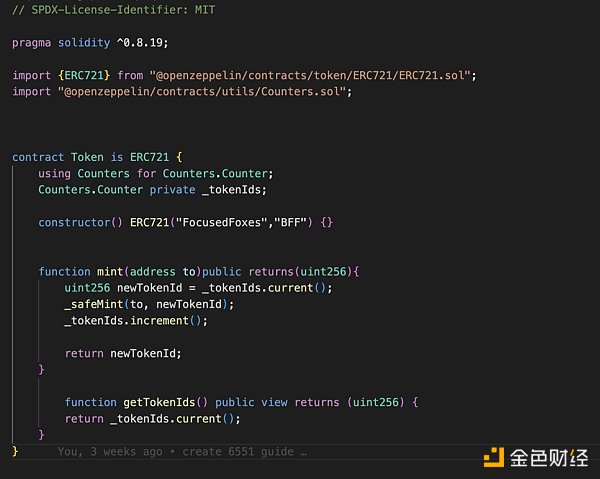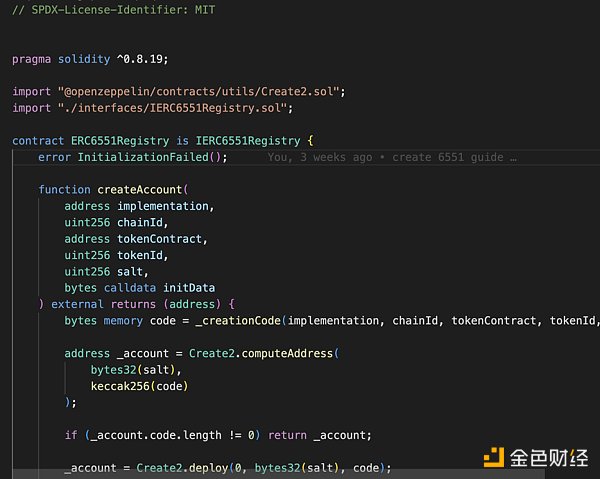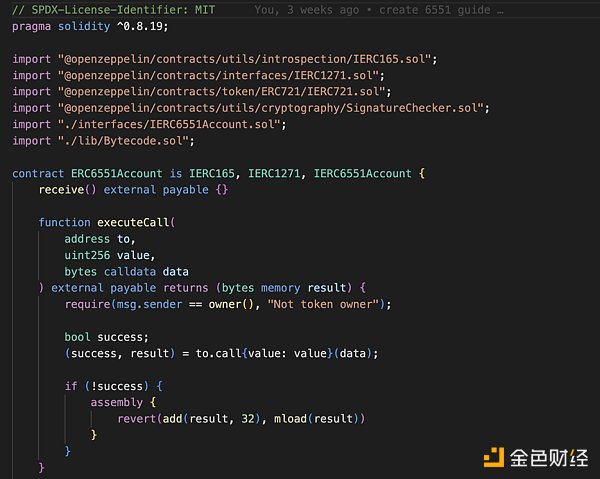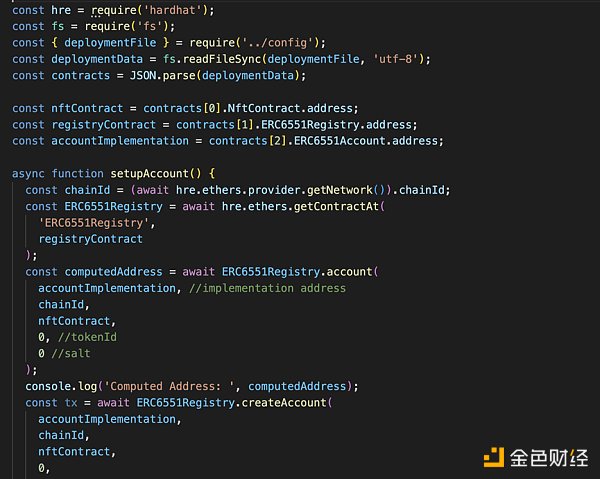Coinbase Unlocking the Future of NFTs – Exploring ERC-6551 Token-Bound Accounts
Coinbase unlocking future of NFTs with ERC-6551 Token-Bound AccountsAuthor: LianGuaitrick Hughes; Coinbase; Translation: Kate, Marsbit
Tl;dr:
Token-Bound Accounts (TBA) add additional utility by equipping new and existing NFTs with smart wallets. TBAs can be used to receive funds or other NFTs, reduce portfolio operational costs, and provide provenance for goods such as coffee. Deploy your NFT and Token-Bound Account on Base using our official guide.
In the world of blockchain and cryptocurrency, innovation never stops. New ideas constantly emerge to change the landscape, making it more universal, secure, and applicable than ever before. One such innovation is ERC-6551, a groundbreaking proposal introduced by Benny Giang and Future Primitive that introduces the concept of Token-Bound Accounts (TBA). In this blog post, we will delve into the world of ERC-6551, unveiling its potential and applicability for enterprise operators, developers, and cryptocurrency enthusiasts.
- Without looking at the process but focusing on the result, what problems can the most dominant architecture of Web3, Intent-Centric, solve?
- AMA with Alex, co-founder of Matter Labs The Final Battle of zkSync
- What can the Intent-Centric architecture, the most domineering architecture of Web3, solve without looking at the process?
ERC-6551 and Smart Wallets
Smart wallets are at the core of ERC-6551’s innovation. Unlike traditional externally owned accounts (EOAs) controlled by private keys, smart wallets are contract-based accounts with programmable capabilities. These smart wallets can store and manage assets, making them the perfect companion for non-fungible tokens (NFTs) in the crypto world. In the case of ERC-6551, NFTs gain an exciting new dimension through their association with these smart wallets, forming token-bound accounts.
When NFTs are equipped with smart wallets, a new realm of possibilities emerges. These token-bound accounts not only store assets and facilitate transactions, but also provide an immutable on-chain history of the NFT’s journey. Just like heirlooms carrying rich and frequently recorded histories, NFTs with smart wallets possess inherent, immutable records of ownership, transactions, and utility. This notable feature captures the essence of provenance, ensuring that on-chain activities of NFTs are transparent and traceable.
The origin of this ownership is directly related to real-world goods such as coffee, clothing, and art. ERC-6551 captures these real-world relationships and transforms them into the digital realm. With each interaction and transaction recorded on the blockchain, the journey of the NFT becomes a part of an immutable narrative, adding depth and authenticity to its identity. This innovation allows NFTs to transcend being mere tokens and assume roles as unique, traceable entities. While on-chain records show the buying, selling, and minting activities of NFTs today, they do not provide a comprehensive view of the NFT’s journey, especially in the context of interactions with other assets or smart contracts. In contrast, the on-chain history of a smart wallet records the interactions that occur within the wallet, reflecting the utility and engagement of the NFT beyond just transfers. This means you can see how it interacts with other tokens, executes transactions, or interacts with decentralized applications (dApps).
Similarities between NFTs, Smart Wallets, and the Real World
In the rapidly developing field of blockchain technology, the combination of NFTs, smart wallets, and their owners has given birth to real-world analogs that go beyond the industry and redefine ownership structures. Consider a family office – a stable entity that manages a diverse investment portfolio including real estate, stocks, bonds, and other valuable assets. Traditionally, such portfolios require complex transactions and interactions, each requiring careful orchestration. The innovation of Token Bound Accounts (TBAs) – a revolutionary concept supported by the ERC-6551 standard – seamlessly connects subsidiary NFTs to a single overarching NFT, introducing a new way to manage and trade assets. This concept leverages the inherent interoperability of blockchain, facilitating rapid integration of innovative protocols. By adhering to the steadfast code-as-law principles of blockchain, ERC-6551 opens the door to tokenizing assets for NFT acceptance. By complying with ERC standards, any asset that conforms to ERC token specifications can be considered as such, expanding the potential of this groundbreaking technology.
In the realm of tokenized real-world assets, a transformative advantage has emerged for investors who frequently manage diverse portfolios of assets such as real estate, stocks, bonds, and physical assets. The innovation of token bound accounts brings a new level of efficiency instead of the complex process of individually selling each asset. Imagine having an ERC-721 token that aggregates several other ERC-721 tokens, each representing different assets. This consolidation of ownership streamlines the process, allowing the entire investment portfolio to be sold through a single NFT. For example, a family office can now offer an NFT representing their collection of tokenized real-world assets, from real estate to stocks, enabling seamless transactions, efficient settlements, and increased liquidity. The elimination of intermediaries, reduction in transaction time, and improved transparency have driven this transformation, opening doors to wider participation and lowering entry barriers. This approach democratizes investment opportunities, making previously inaccessible assets more easily available to a broader range of investors. As ownership patterns evolve, the integration of tokenized assets into powerful NFTs brings dynamic transformation to the management, trading, and diversification of portfolios.
Creating and Controlling Token Bound Accounts
Creating a token bound account involves several basic steps. As we transition from theory to practice, let’s explore each step through code snippets. The code example below provides a glimpse into the process, but for the complete source code and detailed deployment scripts, please visit the Base Guides GitHub page.
Step 1: Minting Your Unique NFT
Before diving into TBA, you need an ERC-721 token, commonly known as NFT. This unique digital asset represents ownership of a unique item, whether it’s artwork, a collectible, or a game character. You can create and mint your own ERC-721 tokens using the appropriate platform or library, such as OpenZeppelin.
Here’s an example of using OpenZeppelin’s ERC721 contract to mint ERC-721 tokens. You can use an online IDE or your local computer:

Step 2: Create and deploy a registry
The core of ERC-6551 is a decentralized registry, which functions like a virtual gallery curator but without the limitations of physical space or exclusive invitations. Imagine NFTs establishing their own identity and ownership through a permissionless and trustless process. This registry establishes a strong connection between NFTs and their smart wallets, similar to how a driver’s license is issued by the DMV. The key difference is that the ERC-6551 registry is completely permissionless and decentralized, allowing users to interact without intermediaries. This registry fundamentally changes the landscape of NFTs by closely linking them to their associated token-bonded accounts, just as the internet transformed communication.
Surprisingly, due to this registry, ERC-6551 is backward compatible, allowing existing ERC-721 tokens created before this proposal to have the ability to possess their own TBA. It’s like opening a door to enhanced ownership for traditional NFTs, injecting new vitality into their potential. This compatibility bridges the gap between the past and the future, allowing the old and new to coexist harmoniously within the scope of ERC-6551.
The “createAccount” function in the provided example ERC6551Registry contract facilitates the creation of TBA by deploying a smart wallet with the specified parameters.
By combining these parameters and hashing them using ‘Create2’, the function calculates the address of TBA. The ‘_creationCode’ function generates bytecode for the smart wallet using the provided parameters. After creating TBA, the function emits an ‘AccountCreated’ event containing relevant information about the newly created TBA.
Here’s a snippet of the registry contract:

Step 3: Deploying smart wallets
Deploying a smart wallet is like setting up a personal bank account for NFTs. Just as you choose a bank to manage your funds, deploying a smart wallet assigns a contract to manage your NFTs. Smart wallets act as guardians of your digital assets, equipped with basic interfaces for interaction and verification. They authorize NFT owners to perform transactions, unlocking the full potential of their assets. In short, this contract enables token-bonded accounts.
Here’s a simplified code snippet of the smart wallet contract:

Step 4: Calculate the Token Binding Account Address
After preparing the ERC-721 token and smart wallet, it’s time to calculate the TBA address for each NFT. This address serves as the unique identifier for the interaction between the NFT and the blockchain. Here, NFTs can airdrop new tokens (ERC-20, ERC-721, etc.), send Ether, or view their transaction history on block explorers like Basescan.

To learn more about implementing ERC-6551, including deployment scripts, please visit the Base Guides GitHub.
Embrace the Future with ERC-6551
In the ever-evolving field of blockchain technology, ERC-6551’s TBA demonstrates the power of innovation. With the fusion of smart wallets and NFTs, a new dimension of ownership is created, with limitless potential applications. From democratized investments to preserving origins and histories, ERC-6551 opens the door to a world where NFTs are not just tokens, but living entities with stories to tell. As a business operator, developer, or crypto enthusiast, you have the opportunity to be at the forefront of this revolutionary change. Explore the code repository provided on the Base Guides GitHub and become part of the movement shaping the future of NFTs. Embrace the power of token binding accounts and embark on a journey of breakthrough innovation and unlocking new possibilities. Together, we are charting a path towards a more interconnected, transparent, and exciting digital era.
We will continue to update Blocking; if you have any questions or suggestions, please contact us!
Was this article helpful?
93 out of 132 found this helpful
Related articles
- Kansas Fed Huge Losses May Result from Purchasing Cryptocurrencies through Cryptocurrency ATMs
- After Friend.tech, how will Base ecology continue?
- What does the US court’s friendly judgment on Uniswap mean for DeFi regulation?
- Can PEPE make a comeback? What do traders and analysts say?
- Digital Asset Lawyer Cryptocurrency Industry in the United States May Be on the Verge of Recovery
- Uniswap wins collective investor lawsuit, becoming a precedent sample in the DeFi regulatory challenge
- What does the US court’s ‘friendly judgment’ on Uniswap mean for DeFi regulation?






